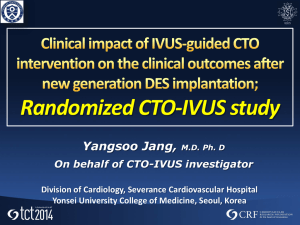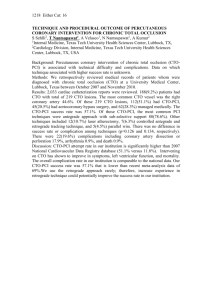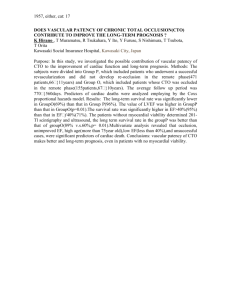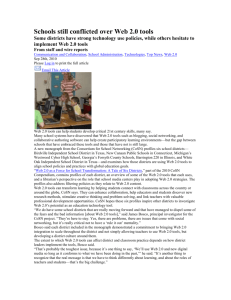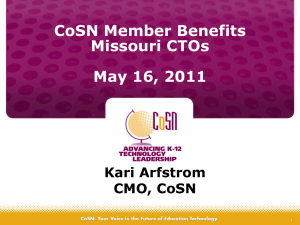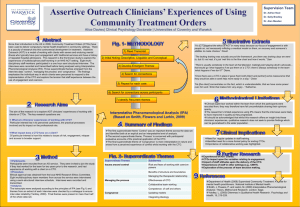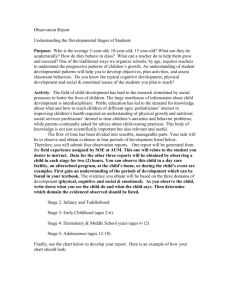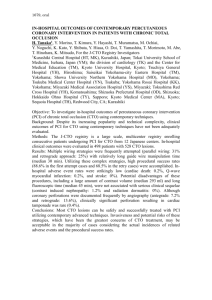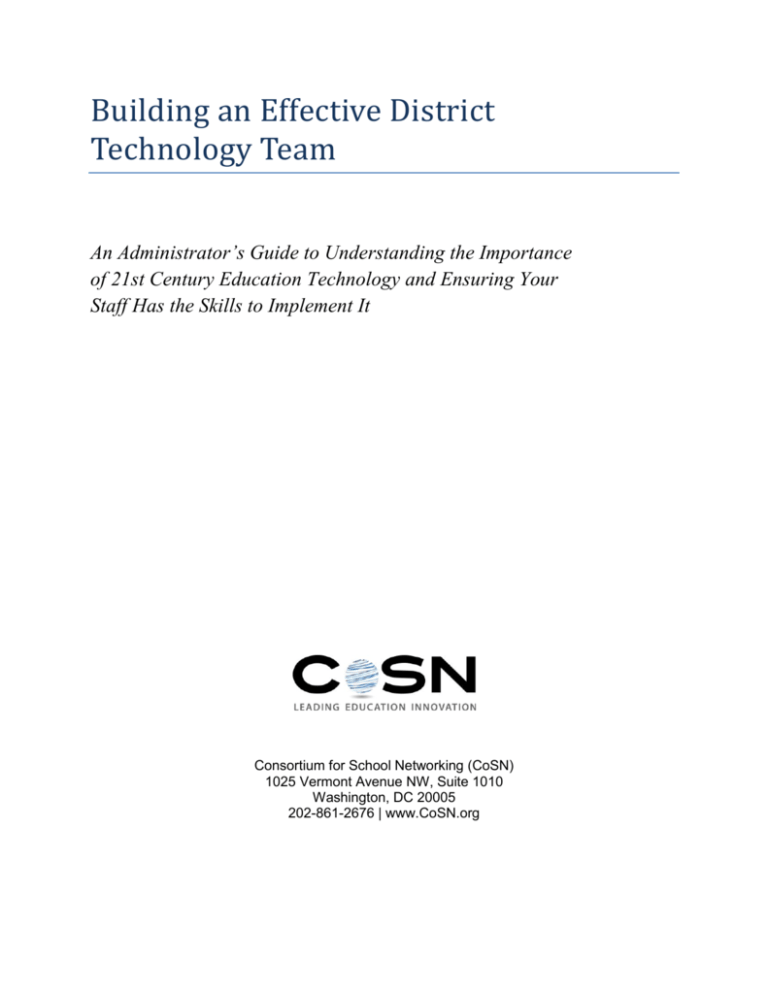
Building an Effective District
Technology Team
An Administrator’s Guide to Understanding the Importance
of 21st Century Education Technology and Ensuring Your
Staff Has the Skills to Implement It
Consortium for School Networking (CoSN)
1025 Vermont Avenue NW, Suite 1010
Washington, DC 20005
202-861-2676 | www.CoSN.org
INTRODUCTION
Who’s in charge of technology in your school district? Who’s making sure that the technology used in
your school district is
Updated and relevant?
Efficiently used?
Cost effective?
Integrated within each and between all of the schools in your entire district?
Technology plays an integral part in all aspects of school life, from its use to engage students, to a
vehicle to connect teachers from across the district, to streamline administrative tasks such as payroll,
to conduct assessment testing, and as an efficient way to communicate with parents and the
community. But who oversees the all-encompassing technology initiatives in your school district?
Education technology leaders are like no other IT professionals. Not only must they know all the current
and emerging technologies, they must have a deep understanding of how this technology can be used to
transform education.
The Consortium for School Networking (CoSN) offers a way for K-12 superintendents and HR
professionals to gauge their technology staff’s understanding of how technology should be used to bring
21st century learning to their schools.
CoSN’s Framework of Essential Skills of the K-12 CTO identifies the 10 skill areas that education
technology leaders must have to successfully implement technology strategies in their education
communities. The Framework has been built and is kept current by practicing education technology
leaders from around the country. The Framework is divided into three equally important categories:
Leadership & Vision, which outlines how education technology leaders can use technology
strategically in their school systems.
Understanding the Educational Environment, which identifies what education technology
leaders must know about the education environment to integrate leading-edge technology to
inform learning.
Managing Technology & Support Resources, which describes the specific skills education
technology professionals must employ to ensure that the technology in their schools systems
are operating at peak performance and cost effectively.
The Consortium for School Networking’s Framework should be used when hiring education technology
professionals, to gauge your current staff’s knowledge of education technology, and to enhance the
skills of those seeking to bring technology to your district. The Framework is also the basis for the new
Certified Education Technology Leader (CETL)TM certification exam. This rigorous, two-part exam
identifies those who have already mastered the skills and knowledge needed to bring 21st century skills
to our schools.
This Toolkit is designed to help superintendents and human resource professionals hire skilled,
knowledgeable education technology leaders who have demonstrated their understanding and
commitment to the best educational technology practices and strategies.
UNDERSTANDING
THE FRAMEWORK OF ESSENTIAL SKILLS OF THE K-12 CTO
Use of technology is transforming how our world works and plays. School systems in the U.S. that don’t
harness technological advances to improve our learning environments are finding themselves and their
students sorely unprepared for the future.
But how are these technologies implemented? With all the choices, which technologies are the best for
your students? It is the responsibility of the district’s Chief Technology Officer (CTO)* to understand the
Superintendent’s vision of bringing 21st century technology to the students and to have the knowledge
and skills to make that vision a reality.
CoSN’s Framework of Essential Skills of the K-12 CTO is designed to identify education technology
leaders who possess these skills. It is also used to identify the skills education technology leaders may
be lacking in order to plot their professional development. The Framework is comprised of three primary
professional categories: Leadership & Vision, Understanding the Educational Environment, and
Managing Technology & Support Resources. Under each of these categories are 10 essential skill areas,
each outlining the responsibilities and knowledge needed to be a successful educational technology
leader. Each of these skills and the related knowledge needed to accomplish them are included in
CoSN’s Certified Education Technology Leader (CETL)TM certification exam.
*CTOs are education technology leaders who are responsible for technology that is increasingly complex, greater in number and scope, and ever more integrated into the daily instructional
and administrative routines of today's school districts. CTOs are known by many titles, including Chief Information Officer and Technology Director.
The Framework’s 10 Skill Areas
Leadership & Vision
Strategic Planning
Ethics & Policies
Instructional Focus & Professional
Development
Team Building & Staffing
Stakeholder Focus
Information Technology Management
Communication Systems Management
Business Management
Data Management
CoSN encourages school leaders and administrators to use the Framework to ensure their technology
staff are helping to prepare the district’s students for the world they’ll inherit.
School Leaders and Administrators Can Use the Framework to:
Recognize and better understand the evolving role of the CTO and how the CTO can elevate
the 21st century learning environment in your school district.
Education leadership positions are defined by a set of competencies and necessary skills, but education
technology leadership positions are relatively new and evolving. The Framework empowers
superintendents, CTOs, and other school leaders with information to better understand the role of the
CTO and how to support visionary technology leadership. What skill set is required for the district’s CTO
to help develop a 21st century learning environment, especially with the challenge of ever-changing
technologies and ever-shrinking budgets? The Framework outlines the range of knowledge and skills a
CTO must have in order to help the district succeed and meet its mission and goals (p.6).
Clearly identify the role of the CTO within your district’s leadership structure and to
encourage participation of the CTO at the cabinet level.
The U.S. Department of Education’s National Educational Technology Plan calls for the district
technology leader to be part of the Superintendent’s Cabinet. And while other education leadership
positions have long been defined and established, the executive role for technology leadership is
relatively new and still only sporadically realized. School district leaders can use the Framework to
identify both the current knowledge and skills of their technology staff (p. 13) and the knowledge and
skills they still need.
Help guide the CTO interview and hiring process.
Superintendents, HR professionals, and School Boards seeking the type of technology leader needed for
21st century school systems can refer to the Framework to help define the profile of the position,
prepare interview questions, and evaluate candidates for the position. This Toolkit includes suggested
interview questions (p.20), which are designed to identify qualified candidates. Also included is a sample
CTO job description (p. 24).
Target professional training needs for your technology staff.
CoSN’s Framework takes into account the evolving role of the CTO and provides a conduit for defining
the professional development needs of these executive-level technology leaders.
What the Research Shows
A report from the National Center for Education Statistics (NCES), Educational Technology in Public
School Districts: Fall 2008 (Gray and Lewis, 2009), found 51% of districts reported employing a full-time
individual responsible for educational technology leadership, and 32% reported a part-time leadership
position. Even in large districts of 10,000 or more students, nearly 20% do not have a full-time
technology leader. In medium sized districts, one third of the schools do not have such a full-time
position.
The statistics for this position by poverty concentration are significant—in wealthy districts with less
than 10% free and reduced lunch, 60% have a full-time technology leader. That number drops to 47% in
districts with more than 20% free and reduced lunch. These statistics are alarming considering the
universal role technology plays in our society. Our nation’s schools must ensure that they have
technology leaders who are able to align how students learn today with what will be expected of them
in the future they’ll inherit.
District technology leaders must be empowered with the range of skills and abilities needed to position
themselves as educational leaders—not just technology leaders. The expanded role of today’s
education technology leader encompasses a broad range of skills including creating a vision of the
transformative role of technology; implementing strategic planning and policy development;
understanding of teaching and learning, assessment, and professional development needs; managing
technology and support resources; and possessing the political and interpersonal skills to effectively
work with all stakeholders.
District leaders must support and nurture the CTO in gaining the expanded set of skills and abilities
necessary for helping the district reach its mission and goals and realize a 21st century learning
environment. The Framework can serve as a roadmap to help your district meet these goals.
the Empowered Superintendent
Evaluation Rubric for the
Chief Technology Officer
There are many challenges for district administrators in
evaluating technology leaders. What should their CTO jobs
entail exactly? How should they be measured?
Although there is not one answer to these questions, this
evaluation rubric developed by CoSN members can get you
started. Based on the CoSN Framework of Essential Skills of
the K–12 CTO, this evaluation rubric captures the skills and
knowledge needed by an educational technology leader.
Skill Area 1.0 Leadership & Vision
1.1. Leadership & Vision
Indicators
Highly Effective (4)
Effective (3)
Improvement Necessary (2)
Fulfills the criteria for Level 3 and
additionally:
• P
articipates with
the administrative
team and advisory
committees to create
and promote a vision
for how technology
will support the
district’s strategic
and operational goals.
• Does not promote
• Occasionally
a vision for how
demonstrates effective
technology will
decision making for
support strategic
meaningful uses of
goals and does
technology to educate
not demonstrate
students, but does not
effective decision
promote a broader vision
making for
for how technology will
meaningful uses
support the district’s
of technology to
strategic and operational
educate students.
goals.
• Works closely with the
executive team and
stakeholders to develop a
shared vision with long-term,
big-picture perspectives
on district goals to plan for
meaningful and effective
uses of technology; provides
leadership when creating a
vision of how technology will
help meet district goals.
• Leverages appropriate
relationships between emerging
technology resources and the
education process on a regular
basis.
• Facilitates the
process of priority
setting and decision
making for meaningful
uses of technology to
educate students.
Ineffective
• Demonstrates an understanding
of assessment, curriculum
and instruction, including their
interdependent relationship and
how technology can support
them.
• Demonstrates the knowledge
and skills necessary to effect
and facilitate change in the
organization.
Developed by the Indiana CTO Council from the CoSN Framework of Essential Skills of the K–12 CTO. Modifications allowed, but attribution must
remain.© Copyright 2012 Consortium for School Networking (CoSN). All rights reserved.
NOTICE: Reproduction of this document or any of our webpages or their contents at other websites, in machine readable or electronic or other
soft copy form, is prohibited; reproduction in printed documents for sale is also prohibited. Permissions must be granted explicitly by CoSN and
copyright ownership noted. http://www.cosn.org/Portals/7/docs/Certification/Framework_1212_2011_Public.pdf
1.2 Strategic Planning
Indicators
Highly Effective (4)
Effective (3)
Fulfills the criteria for Level 3 and
additionally:
• Works with key system
leaders to identify priorities
needed to meet strategic
goals.
• Has a high-level view across
the school system and works
with instructional and technical
teams to identify steps needed
to transform the technology
vision into a long-range plan,
complete with specific goals,
objectives and action plans.
• Demonstrates strategic ability
and innovation in leading,
planning and implementing the
district’s goals and objectives.
• Articulates and leverages the
VOI (value of investment) in
technology to ensure effective
delivery of services aligned to
the district vision and goals.
• Promotes and leads the
implementation of industry
best practice methodologies,
tools and programs in support
of technology.
Improvement
Necessary (2)
Ineffective
• Does not
•D
evelops
effectively work
technology budgets
with key system
and demonstrates
leaders to identify
some understanding
priorities, budget
of district systems,
• Works with key system
and funding
but does not
leaders to identify budget and
mechanisms.
effectively work with
funding mechanisms needed
key system leaders
• Fails to
to meet strategic goals.
to identify priorities,
demonstrate
• Knows the current goals of
budgets and
understanding of
the school district and aligns
funding mechanisms
district systems.
the technology department
to meet strategic
work with those goals.
goals.
• Has strategic understanding
of district systems (e.g.
instruction, assessment,
finance, facilities, transportation, security, food
service and others) in order to
provide leadership regarding
how technology can support
them.
1.3 Ethics & Policies
Fulfills the criteria for Level 3 and
additionally:
• Manages the creation,
implementation and
enforcement of policies and
educational programs relating
to the social, legal and ethical
issues related to technology
use throughout the district
and modeling responsible
decision-making.
• Demonstrates commitment
to responsible environmental
protection and energy-saving
practices.
• Actively participates in the
policy development process
and ensures policy supports
a high- performing learning
environment.
• Facilitates equitable access to
technology resources for all
stakeholders.
Consortium for School Networking
•M
odels and assures
adherence to state and
federal laws.
•D
emonstrates high standards
of integrity and professional
conduct with consideration
for fairness and honesty.
• Communicates to
stakeholders appropriate
ethical and professional
behavior for technology use
in the district.
•M
odels and assures
awareness about pertinent
laws and legal issues related
to implementation and use
of technology in a district
(e.g., copyright, privacy and
compliance).
emonstrates knowledge
•D
of vulnerabilities and issues
pertaining to the safety of
students and staff.
• Models appropriate
ethical and
professional
behavior for
technology, but
does not effectively
communicate
policies and
practices to
stakeholders.
• Inconsistently
demonstrates
high standards
of integrity and
professional
conduct with
consideration
for fairness and
honesty.
• Fails to model
appropriate ethical
and professional
behavior for
technology,
and does not
effectively
communicate
policies and
practices to
stakeholders.
• Fails to
demonstrate
high standards
of integrity and
professional
conduct with
consideration
for fairness and
honesty.
2.0 Understanding the Educational Environment
2.1 Instructional Focus & Professional Development
Indicators
Highly Effective (4)
Effective (3)
Improvement Necessary (2)
Ineffective
Fulfills the criteria for Level
3 and additionally:
• Plans for and
coordinates purposeful
professional
development.
• Assists with professional
development, but does
not provide ongoing
opportunities for staff.
• Provides little or
no professional
development
opportunities for staff.
• Identifies and promotes
how technology can
support educational
best practices through
communication and
collaboration with the
district instructional
leadership.
•R
esponds to technology
requests, but does not
regularly identify and
promote how technology
can support educational
best practices.
• Fails to identify and
promote how technology
can support educational
best practices.
• Budgets, plans and
coordinates ongoing,
purposeful professional
development for all staff
using technologies;
ensures a sufficient
budget through the
implementation and
assessment process of
emerging technologies.
• Empowers staff to
reach a proficiency level
to meet the ongoing
demands of their jobs.
• Promotes standards for
innovative teaching and
learning that develop
student proficiency in
21st century skills.
• Stays abreast of
state and national
standards, benchmarks
and frameworks for
technology literacy.
• Promotes the application
of technology to address
the diverse needs of
students and maximize
student learning.
2.2 Team Building & Staffing
Indicators
Highly Effective (4)
Effective (3)
Improvement Necessary (2)
Ineffective
Fulfills the criteria for Level
3 and additionally:
• Builds an environment of
trust through communication and transparency
about decisions and how
they are made.
• Frequently makes
decisions without
communicating how or
why they are made.
• Rarely communicates
how or why decisions
are made.
• Plays an integral role in
the district’s strategic
planning process;
creates and supports
cross-functional
teams for decision
making, technology
support, professional
development and other
aspects of the district’s
technology program.
• Mentors and empowers
others to assume
leadership roles.
Consortium for School Networking
• Sets clear objectives and
measures and monitors
process, progress and
results.
• Analyzes and identifies
on an ongoing basis
individual and team
strengths, required
areas of growth
and how teams and
their members are
being deployed and
redeployed.
• Objectives and measures
are not clear and not
monitored process,
progress and results.
• Occasionally (but not
on an ongoing basis)
analyzes and identifies
individual and team
strengths, required
areas of growth,
and how teams and
their members are
being deployed and
redeployed.
• Does not establish clear
objectives and measures
and doesn’t monitor
process, progress and
results.
• Rarely analyzes and
identifies individual
and team strengths,
required areas of
growth, and how teams
and their members are
being deployed and
redeployed.
2.2 Team Building & Staffing (continued)
Indicators
Highly Effective (4)
Effective (3)
Improvement Necessary (2)
Ineffective
• Creates cross-functional
teams involving
stakeholders for
appropriate aspects of
the district’s technology
program.
• Makes effective hiring
decisions.
• Frequently makes poor
hiring decisions.
• Frequently makes poor
hiring decisions.
• Provides feedback to
individuals and teams on
a regular basis regarding
areas of strength
and required growth,
using quantitative and
qualitative data.
• Sporadically provides
feedback to individuals
and teams regarding
areas of strength
and required growth,
but often does not
use quantitative and
qualitative data.
• Rarely provides feedback
to individuals and teams
regarding areas of
strength and required
growth and does not
use quantitative and
qualitative data when
doing so.
Highly Effective (4)
Effective (3)
Improvement Necessary (2)
Ineffective
Fulfills the criteria for Level
3 and additionally:
• Effectively
communicates with
stakeholders a vision
for how technology will
support the district’s
strategic goals.
• Does not clearly
communicate with
stakeholders a vision
for how technology will
support the district’s
strategic goals.
• Does not communicate
with stakeholders
a vision for how
technology will support
the district’s strategic
goals.
• Builds positive
relationships with
stakeholders.
• Has some positive
relationships with
stakeholders, but also
regularly upsets or
frustrates stakeholders.
• Does not build positive
relationships with
stakeholders.
2.3 Stakeholder Focus
Indicators
• Builds relationships with
all stakeholders, taking
a close look at how
the district determines
requirements,
expectations and
preferences.
• Understands the key
factors that lead to
stakeholder satisfaction,
focusing on how
the district seeks
knowledge, satisfaction
and loyalty of students
and other stakeholders.
• Collaborates with
stakeholders to create
a vision for how
technology will support
the district’s strategic
goals.
• Builds and leverages
effective partnerships
with organizations
that benefit district
stakeholders.
• Attempts to assess
and respond to needs
and concerns of
nearly all workers and
stakeholders.
Consortium for School Networking
• Assesses and responds
to needs and concerns
of most workers and
stakeholders.
• Assesses and responds
to needs and concerns,
but often does not meet
the needs of workers
and stakeholders.
• Frequently does not
assess and respond to
needs and concerns of
workers.
3.0 Managing Technology
3.1 Information Technology Management
Indicators
Highly Effective (4)
Effective (3)
Improvement Necessary (2)
Ineffective
Fulfills the criteria for Level 3
and additionally:
• Effectively plans,
implements and
sustains all tasks
related to technical
systems, network
infrastructure and
computing device
management.
• Although some projects
are well planned and
implemented, most are
poorly planned and are
often reactionary in
nature.
• Projects are poorly
planned and
implemented.
• Directs, coordinates, and
ensures implementation
of all tasks related to
technical systems,
network infrastructure,
standards, and integration
of technology into every
facet of district operations.
• Effectively plans,
implements and sustains
all tasks related to
technical systems,
network infrastructure
and computing device
management.
• The approach to projects
consistently is proactive to
current and future district
needs.
• System resources are
rarely interrupted.
• Evaluates all tasks related
to technical systems,
network infrastructure
and computing device
management.
• Effectively directs,
coordinates and ensures
implementation of all tasks
related to the integration
of technology into district
operations.
• Ensures that disaster
recovery and business
continuity plans are
an integral part of the
district’s technology
program.
Consortium for School Networking
• The approach to
projects is usually
proactive.
• System resources
generally perform well
and issues are resolved
quickly and accurately.
• Establishes a disaster
recovery and business
continuity plan.
• Issues are occasionally
overlooked or not
addressed promptly or
accurately.
• System resources are
often disrupted, but
are usually addressed
relatively promptly.
• There are strategies and
methods in place for
disaster recovery and
business continuity, but
no written plan.
• Solutions are usually
reactionary in nature
and frequently need to
be re-reported.
• System resources are
generally unreliable
and frequently disrupt
operations.
• There are minimal
or no strategies and
methods in place for
disaster recovery and
business continuity.
3.2 Communication Systems Management
Indicators
Highly Effective (4)
Effective (3)
Improvement Necessary (2)
Ineffective
Fulfills the criteria for Level 3
and additionally:
• Regularly directs and
coordinates use of
email, district websites,
web tools, voicemail
systems and other
forms of communication.
• Occasionally directs and
coordinates use of email,
district websites, web
tools, voicemail systems
and other forms of
communication.
• Demonstrates working
knowledge of various
communication tools
and techniques.
• Manages support
issues related to
communication systems,
but many systems are
outdated.
• Rarely directs and
coordinates use
of email, district
websites, web tools,
voicemail systems
and other forms of
communication.
• Uses technology to
improve communications,
directing and coordinating
the use of email, district
websites, web tools, voice
mail systems and other
forms of communication to
facilitate decision making
and to enhance effective
communication with key
stakeholders.
• Develops and implements
procedures, strategies
and technical solutions for
keeping teacher websites,
school web resources, and
other communication tools
updated, relevant and
operational.
• Effectively manages
support issues
related to keeping
communication systems
updated, compliant and
operational.
• Communication systems
are often unreliable
• Does not effectively
manage support
issues related to
communication
systems.
• Communication
systems are frequently
unreliable.
• Communication systems
are reliable for users.
• Reviews and uses
emerging technologies
that enhance
communication.
• Communication systems
are very reliable with
robust features and
functionality.
3.3 Business Management
Indicators
Highly Effective (4)
Effective (3)
Improvement Necessary (2)
Ineffective
Fulfills the criteria for Level 3
and additionally:
•D
emonstrates
knowledge of funding
sources available
to the district and
appropriately leverages
them to meet district
and programmatic
goals.
• Develops and manages
budgets, but often
requires prompting,
assistance and/or
oversight.
•D
oes not effectively
develop and
manage budgets.
• Manages the budget and
serves as a strong business
leader who guides purchasing
decisions, determines the
return on investment for all
technology implementations,
and fosters good relationships
with vendors, potential funders
and other key groups.
•D
evelops and manage
budgets, both annually
and long-range.
• Understands and
applies principles
of TCO and VOI of
technology initiatives.
Consortium for School Networking
• Understands and
applies principles of TCO
and VOI of technology
initiatives only on
sporadic occasions.
• Purchasing decisions
are often proven to be
undervalued solutions.
• Fails to understand
and apply principles
of TCO and VOI
of technology
initiatives
•P
urchasing
decisions are
regularly proven
to be undervalued
solutions.
3.3 Business Management (continued)
Indicators
Highly Effective (4)
Effective (3)
• Pursues and secures grant
opportunities or funding
sources with low interest
rates.
•M
akes effective
purchasing decisions
following relevant laws,
policies and guidelines.
• Pursues and secures cost
reduction or cost shifting
measures to fund technology
initiatives.
• Understands and
applies basic financial
and accounting
principles and
processes and all
regulatory guidelines
applicable to district
funds.
•D
irects, manages and
negotiates with vendors
and business partners.
Improvement Necessary (2)
• Directs, manages and
negotiates with vendors
and business partners,
but often requires
prompting, assistance
and/or oversight.
• Participates in tasks
related to selection and
purchasing (e.g., RFPs,
purchasing guidelines),
but often requires
prompting, assistance
and/or oversight.
•D
irects, coordinates and
ensures implementation
of all tasks related
to selection and
purchasing (e.g., RFPs,
purchasing guidelines).
Ineffective
•D
irects, manages
and negotiates
with vendors
and business
partners, but often
requires prompting,
assistance and/or
oversight
•P
articipates in tasks
related to selection
and purchasing (e.g.,
RFPs, purchasing
guidelines), but
often requires
prompting,
assistance and/or
oversight.
3.4 Data Management
Indicators
Highly Effective (4)
Effective (3)
Improvement Necessary (2)
Ineffective
Fulfills the criteria for Level 3
and additionally:
• Establishes systems
and tools for gathering,
warehousing, mining,
integrating and
reporting data in usable
and meaningful ways.
• Maintains systems and
tools for gathering,
warehousing, mining,
integrating and
reporting data, but does
not look for ways to
improve those systems.
• Fails to implement
and support tools
for gathering,
warehousing, mining,
integrating and
reporting data in
usable and meaningful ways.
• Manages the establishment
and maintenance of systems
and tools for gathering, mining, integrating and reporting
data in usable and meaningful
ways to produce an information culture in which data
management is critical to
strategic planning.
• Participates with the
administrative team and
advisory committees to create
and promote a vision for how
data reporting will support
the district’s strategic and
operational goals.
• Facilitates the process of
priority setting of the district’s
data analysis needs.
• Coordinates training
opportunities for teachers and
administrators in making good
uses of data systems.
Consortium for School Networking
• Maintains systems and
tools for gathering,
warehousing, mining,
integrating and
reporting data in usable
and meaningful ways.
• Inconsistently utilizes
data-driven decision
making and related
processes in support of
stakeholders.
• Utilizes data-driven
decision making and
related processes in
support of stakeholders.
• Does not consistently
remain current on
data related industry
standards (e.g., SIF).
• Remains knowledgeable
about data related
industry standards (e.g.
SIF).
• Inconsistently responds
to information reporting
requirements related to
government mandates
• Assesses and responds
to information reporting
requirements related to
government mandates.
• Rarely utilizes
data-driven decision
making and related
processes in support of stakeholders.
• Does not consistently remain current
on data related
industry standards
(e.g., SIF).
• Frequently fails to
respond to information reporting
requirements related
to government
mandates
the Empowered Superintendent
Self-Assessment
for Chief Technology Officers
and Technology Staff
10 Essential Skill Areas in
Three Professional Categories
Leadership & Vision
1. Leadership & Vision
2. Strategic Planning
3. Ethics & Policies
Understanding the
Educational Environment
4. Instructional Focus & Professional Development
5. Team Building & Staffing
6. Stakeholder Focus
Managing Technology &
Support Resources
7. Information Technology Management
8. Communication Systems Management
9. Business Management
10. Data Management
Plus: Core Values & Skills
Critical personal skills and behaviors
—CoSN’s Framework of Essential Skills of the K–12 CTO
Leadership & Vision
Leadership & Vision Working closely with the executive team and stakeholders to develop a shared vision
with long-term, big-picture perspectives on a district’s goals to plan for meaningful and effective uses of
technology; providing leadership into creating a vision of how technology can help meet district goals.
Excel
(5)
1
Champion and model effective/innovative use of educational
technologies.
2
Identify core business and culture of the school organization.
3
Establish and lead advisory committees and facilitate process of
priority setting and decision-making.
4
nvision relationships among emerging technology resources
E
and the education process.
5
escribe the relationship among technology, assessment,
D
curriculum and instruction
6
Manage the change process and deal effectively with ambiguity
7
Work jointly with other units to assist them in using technology
more effectively and efficiently.
InterProficient mediate
(4)
(3)
Basic
(2)
Need
help!
(1)
Strategic Planning Having a high-level view across the school system of things needed to be successful;
working with the instructional and technical teams to identify the steps needed to transform the
technology vision into a long-range plan, complete with specific goals, objectives and action plans.
Excel
(5)
8
Demonstrate a strategic approach and innovation in leading,
planning and implementing district goals, including developing
and evaluating the district’s technology plan.
9
Work with key system leaders, people networks (e.g., math
teachers) and departments to identify budget and funding
mechanisms and lead the district from vision to realization of
goals.
10
Assemble and lead implementation of industry best practice
methodologies, tools and programs such as total cost of
ownership (TCO) and value of investment (VOI) in support of
technology
11
Explain the impact and need for technology throughout the
enterprise (e.g., instruction, assessment, finance, facilities,
transportation, security, food service and others) to provide
leadership regarding how technology can support each.
12
Inform the organization of risk management strategies and
design risk mitigation strategies in support of business and
instructional initiatives.
Consortium for School Networking
InterProficient mediate
(4)
(3)
Basic
(2)
Need
help!
(1)
Ethics & Policies Overseeing the creation, implementation and enforcement of policies and educational
programs relates to the social, legal and ethical issues involved in technology use throughout the district
and modeling of responsible decision making.
Excel
(5)
13
Demonstrate high standards of integrity and professional
conduct with consideration for fairness and honesty.
14
Work closely with all stakeholders to ensure adherence to state
and federal guidelines, regulations and laws.
15
Identify relevant issues including safety, technologyrelated health concerns and guidelines for fair and ethical
implementation of technology.
16
Incorporate responsible environmental protection and energysaving practices in all technology–related activities.
17
Participate in the policy development process to ensure that
appropriate technology supports a high-performing learning
environment and equitable access for all stakeholders.
InterProficient mediate
(4)
(3)
Basic
(2)
Need
help!
(1)
Understanding the Educational Environment
Instructional Focus & Professional Development Budgeting for, planning for and coordinating ongoing,
purposeful professional development for all staff using technologies, including ensuring a sufficient budget
through the implementation and assessment process of emerging technologies.
Excel
(5)
18
Design and coordinate professional development to develop
teachers’ technology proficiency for 21st century teaching and
learning..
19
Identify standards for innovative teaching and learning that
develop student proficiency in 21st century skills.
20
Model how technology can support educational best practices
through collaboration with the district instructional leadership.
21
Summarize the application of technology to address diverse
needs of students and maximize student learning.
22
Monitor state and national standards, benchmarks and
frameworks for educational technology.
23
Develop and coordinate professional development for staff
to increase staff technology proficiency level and maximize
business efficiency.
24
erve as a member of other district cross-functional project
S
teams.
Consortium for School Networking
InterProficient mediate
(4)
(3)
Basic
(2)
Need
help!
(1)
Team Building & Staffing Creating and supporting cross-functional teams for decision-making, technology
support, professional development and other aspects of the district’s technology program as an integral
part of strategic planning.
Excel
(5)
25
26
InterProficient mediate
(4)
(3)
Basic
(2)
Need
help!
(1)
Demonstrate strong leadership skills and mentor others to
assume leadership roles..
Coordinate and lead cross-functional teams to best address the
district strategic plan
27
Build an environment of trust through communication and
transparency about decisions and how they are made.
28
Incorporate quality improvement tools for decision-making.
29
Identify strengths and areas of need to make effective hiring
decisions.
30
Ensure appropriate expertise is available to support different
aspects of the IT program.
31
Nurture an environment that encourages communication among
team members.
Stakeholder Focus Using knowledge you have about stakeholders and building relationships with all of
them; taking a close look at how the district determines requirements, expectations and preferences of
stakeholders as well as the key factors that lead to stakeholder satisfaction; understanding how the district
seeks knowledge, satisfaction and loyalty of students and other stakeholders.
Excel
(5)
32
33
Develop buy-in for the vision for the district’s technology
program.
Communicate using emerging collaborative technologies to
reach stakeholders.
34
Build relationships with stakeholders.
35
Develop effective partnerships with organizations that benefit
district stakeholders.
36
ssess and respond to needs and concerns of all knowledge
A
workers and stakeholders.
Consortium for School Networking
InterProficient mediate
(4)
(3)
Basic
(2)
Need
help!
(1)
Managing Technology & Support Resources
Information Technology Management Directing, coordinating and ensuring implementation of all tasks
related to technical, infrastructure, standards and integration of technology into every facet of district
operations—among the many things considered are systems administration, backup and storage, data
security, disaster recovery, network infrastructure, network management, network security, Internet
bandwidth, federal and state compliance, desktop support and others.
Excel
(5)
37
Demonstrate knowledge and expertise about technical systems,
network infrastructure and computer management
38
Plan, implement and sustain all tasks related to technical systems, network infrastructure and desktop/notebook computer
management.
39
Develop, collect, interpret and report IT metrics for all aspects of
the IT system.
40
Make purchasing and implementation decisions based on needs
of the total school system—and on an understanding of the full
life cycle of technology purchases.
41
Set practical and realistic timelines for technology
implementation.
42
Develop disaster recovery and business continuity plans that
are an integral part of the district’s technology program
InterProficient mediate
(4)
(3)
Basic
(2)
Need
help!
(1)
Communication Systems Management Using technology to improve communication; directing and
coordinating the use of email, district websites, web tools, voice mail systems and other forms of
communication to facilitate decision-making and enhance effective communication with key stakeholders.
Excel
(5)
43
Direct and coordinate use of email, district websites, web tools,
voice systems and other forms of communication.
44
Describe current and emerging communication tools, including
emerging communication technologies to enhance engagement
online
45
Explain technical issues related to implementation of a range of
communication tools
46
Describe technical support issues and staffing needed to
keep district communication systems updated, compliant and
operational
47
Identify design, accessibility and compliance issues necessary
for keeping district, school and teacher websites and other communication tools updated and operational.
Consortium for School Networking
InterProficient mediate
(4)
(3)
Basic
(2)
Need
help!
(1)
Business Management Managing budgets and serving as a strong business leader who guides purchasing
decisions, assists in determining return on investment for all technology implementations and fosters good
relationships with vendors, potential funders and other key groups.
Excel
(5)
48
Identify funding sources available to the district and appropriately leverage them to meet district and programmatic goals.
49
Manage annual and long-term budgets, making purchasing decisions and coordinating all purchasing-related tasks.
50
pply basic financial and accounting principles and processes
A
following relevant laws, policies and guidelines.
51
Analyze market rates for acquisition of technology equipment
and services, considering issues that determine TCO and VOI.
52
Negotiate and maintain relationships with vendors and business
partners.
InterProficient mediate
(4)
(3)
Basic
(2)
Need
help!
(1)
Data Management Overseeing the establishment and maintenance of systems and tools for gathering,
mining, integrating and reporting data in usable and meaningful ways to produce an information culture in
which data management is critical to strategic planning.
Excel
(5)
53
escribe data-driven decision making and the role informaD
tion plays in shaping and supporting a district’s educational
programs.
54
Explain techniques and tools for data gathering, warehousing,
mining, integrating and reporting data in useable and meaningful
ways.
55
Support district data-driven decision making initiatives.
56
Identify data-related industry standards and governmental
mandates with information reporting requirements.
57
se data-driven decision making to assess and respond to
U
needs and concerns of a variety of knowledge workers.
Consortium for School Networking
InterProficient mediate
(4)
(3)
Basic
(2)
Need
help!
(1)
Core Values & Skills
These underlying values and skills cut across all others and are ones found in effective CTOs. They represent critical personal skills and behaviors necessary for accomplishing all other identified competencies.
Excel
(5)
58
Communicate directly, honestly and respectfully.
59
ffectively communicate in all forms of speaking, writing and
E
presenting, using emerging communication technologies when
appropriate.
60
Demonstrate courage.
61
Be flexible, credible and adaptable.
62
e results-oriented in both organizational improvement and
B
personal learning.
63
L ead for innovation, modeling behaviors others are encouraged
to adopt.
Consortium for School Networking
InterProficient mediate
(4)
(3)
Basic
(2)
Need
help!
(1)
THE EMPOWERED SUPERINTENDENT
INTERVIEW QUESTIONS FOR HIRING
AN EDUCATIONAL TECHNOLOGY LEADER
When you are seeking to hire a Chief Technology Officer (CTO)
or Technology Director for your school district, you want to
ensure that this person has extensive technology experience
and can apply these skills in an educational environment.
Your CTO will be working with Chief Academic Officers,
Chief Financial Officers, Chief Operating Officers and others at
the district level, as well as principals, teachers, parents and
the School Board. This person needs to have the leadership
skills necessary to effectively communicate with these
various stakeholders.
CoSN has developed this set of interview questions that
will help you gauge CTO candidates’ knowledge and skill
levels. These questions are based on the 10 skill areas of the
CoSN Framework of Essential Skills of the K–12 CTO.
LEADERSHIP & VISION
Work closely with the executive team and stakeholders to develop
a shared vision with long-term, big-picture perspectives on district
goals to plan for meaningful and effective uses of technology, and
to provide leadership when creating a vision of how technology will
help meet district goals.
Interview Questions
1. Describe how you have created a plan to integrate education
technology into the district’s strategic and operational goals.
2. W
hich stakeholders did you need to include or consult with when
formulating this plan?
3. How did you measure the cost-effectiveness of your strategic
plan?
4. How did you measure its overall effectiveness?
5. How did you mitigate the risk of implementing your plan?
STRATEGIC PLANNING
Have a high-level view across the school system and work with
instructional and technical teams to identify steps needed to
transform the technology vision into a long-range plan, complete
with specific goals, objectives and action plans.
Interview Questions
1. What do you see are the three most promising technologies on
the horizon for today’s educational environment?
2. D
escribe how you would build a coalition with district
stakeholders to implement these technologies.
ETHICS & POLICIES
Manage the creation, implementation and enforcement of policies
and educational programs relating to the social, legal and ethical
issues of technology use throughout the district and modeling
responsible decision-making.
Interview Questions
1. Describe the ways in which you have safeguarded students’
safety and privacy as it relates to technology use.
2. W
hat federal laws are we obligated to adhere to as they relate to
children’s online safety?
INSTRUCTIONAL FOCUS &
PROFESSIONAL DEVELOPMENT
Budget, plan and coordinate ongoing, purposeful professional
development for all staff using technologies; ensure a sufficient
budget through the implementation and assessment process of
emerging technologies.
Interview Questions
1. Describe how you have ensured that your staff stays current
about the latest trends and technologies emerging in the
education field.
2. H
ow have you enhanced students’ learning through the use of
technology?
3. How have you kept other stakeholders (such as superintendents,
faculty, etc.) informed on new technologies that can enhance
learning?
TEAM BUILDING & STAFFING
Play an integral role in the district’s strategic planning process;
create and support cross-functional teams for decision-making,
technology support, professional development and other aspects
of the district’s technology program.
Interview Questions
1. What is your philosophy on managing or collaborating with
cross-functional teams?
2. H
ow have you ensured that all participants are equally
represented?
3. How have you handled conflicts that arise among crossfunctional teams?
CONSORTIUM FOR SCHOOL NETWORKING
STAKEHOLDER FOCUS
Build relationships with all stakeholders, taking a close look at
how the district determines requirements, expectations and
preferences. Understand the key factors that lead to stakeholder
satisfaction, focusing on how the district seeks knowledge,
satisfaction and loyalty of students and other stakeholders.
Interview Questions
1. There are many stakeholders in the education environment.
Besides the administration staff, teachers and students, name at
least three other stakeholder groups you have worked with and
how you determined their expectations and requirements.
2. H
ow did you prioritize their conflicting expectations or needs?
INFORMATION TECHNOLOGY
MANAGEMENT
Direct, coordinate and ensure implementation of all tasks related to
technical, infrastructure, standards and integration of technology
into every facet of district operations.
Interview Questions
1. What are your experiences using cloud computing? What were
the advantages and disadvantages?
2. W
hen does it make more sense to outsource? What are the
advantages and disadvantages of outsourcing?
3. Describe how you have developed and implemented a disaster
recovery and business continuity plan.
COMMUNICATION SYSTEMS
MANAGEMENT
Use technology to improve communication, directing and
coordinating the use of email, district websites, web tools, voice
mail systems and other forms of communication to facilitate
decision-making and to enhance effective communication with key
stakeholders.
Interview Questions
1. What techniques and technologies have you implemented to
improve communication district-wide?
2. W
hat were some of the challenges you encountered using
district-wide communications tools?
CONSORTIUM FOR SCHOOL NETWORKING
BUSINESS MANAGEMENT
Manage the budget and serve as a strong business leader who
guides purchasing decisions, determines the return on investment
for all technology implementations and fosters good relationships
with vendors, potential funders and other key groups.
Interview Questions
1. Describe your experiences in creating and managing a districtwide technology budget.
2. H
ow did you make purchasing decisions? In making these
decisions, how did you forecast the technology’s total cost of
ownership?
3. How did you measure the return on investments?
4. How did you decide whether to purchase or lease equipment?
DATA MANAGEMENT
Manage the establishment and maintenance of systems and tools
for gathering, mining, integrating and reporting data in usable and
meaningful ways to produce an information culture in which data
management is critical to strategic planning.
Interview Questions
1. How have you used actionable data to increase student success?
2. W
hat technology systems have you used to collect, analyze and
disseminate data that ultimately informs instruction?
3. How did you ensure the integrity and authenticity of the
collected data?
4. H
ow did you ensure the security of the collected data?
CONSORTIUM FOR SCHOOL NETWORKING
the Empowered Superintendent
Job Description for a Chief Technology
Officer or Technology Director
Job Goals
•P
rovide leadership in identifying, assessing and managing technology needs for the school system to the Superintendent and other
stakeholders.
•D
irect, coordinate, supervise, facilitate or perform all tasks and elements
needed to effect comprehensive integration of appropriate technology
into every facet of operations.
•C
ontribute to the infusion of educational technology into classrooms,
libraries/media centers and district offices by providing highly motivating, full-time, professional leadership in all areas of technology planning
and technology resource management.
Qualifications
•M
inimum of a master’s degree in a related field
•D
emonstrated professional experience in a technology leadership role
•A
t least four years’ experience in K–12 education preferred
•D
emonstrated written and verbal communication skills, as well as
speaking and presentation skills
•C
ertified Education Technology Leader (CETL) certification required or
must be attained within one year of hire
Essential Duties
•P
rovide leadership in all aspects of technology for the school system.
•C
oordinate development, refinement and execution of the district strategic plan, involving all stakeholders and governance committees.
•C
ollaborate with the Superintendent and Cabinet to make informed
decisions.
ollaborate with principals and school staff to make informed decisions.
•C
• L ead district initiatives, collaborating across departments and functional
areas that support adoption and implementation of technology in all
aspects of school business, including those that improve teaching and
learning and promote 21st century skills.
•C
reate and support cross-functional teams for needs assessment,
decision-making, technology support, professional development and
other aspects of the district technology program.
•M
anage and direct staff in support of all technology applications to help
the district meet goals of the strategic plan.
•S
upervise or coordinate the skills development of all employees in the
operation of technology. Build awareness among employees of available
resources and the role of technology in the instructional process.
•D
evelop and coordinate a broad range of technology-based resources,
maximizing the availability and use of these resources.
the Empowered Superintendent
CETL Certification for Educational
Technology Staff
T
he Certified Education Technology Leader (CETL™) examination is
a rigorous, two-part exam that identifies those who have mastered the framework skills and knowledge needed to bring 21st
century skills to schools. The exam is a true measure of today’s
education technology field. The CETL program is also professional development to enhance the knowledge of learning technologies.
Superintendents who have encouraged CETL certification report
these benefits:
• Stakeholders see that they are committed to the highest standards in
administration.
• They hire and promote only the most skilled and knowledgeable education technologists.
• Their districts keep current on latest trends and best practices in
education technology.
• Asking for CETL demonstrates commitment to their employees’ professional growth.
• The technology team skills are well matched to the job requirements of
their positions.
More than half
of CETL-certified
educational
technology leaders
hold district,
cabinet-level
positions.
The Examination
Only candidates passing both parts of the two-part exam earn the CETL
designation. Candidates must pass Part I to be eligible to take Part II.
•P
art I is a multiple-choice exam administered at proctored sites
throughout the country. It identifies those who have a clear understanding of best practices, federal laws, and existing and emerging technologies in the education technology field.
• A critical aspect of a CTO’s role is to effectively communicate highly
technical concepts to a broad stakeholder base. The essay-based Part
II tests the candidate’s on this and is graded by a panel of experts
trained by testing specialists using a pre-determined rubric.
Consortium for School Networking
Eligibility Requirements
• A bachelor’s degree plus four years of educational technology experience
• Educational technology experience is defined as demonstrable experience
in the three overarching skills areas of the CoSN Framework of Essential
Skills of the K–12 CTO.
To stay current in the field, CETL-certified professionals must recertify by
completing 60 hours of continuing education during a three-year certification
cycle.
Preparing for the Exam
Completing specific prep courses is not required to sit for the exam.
Applicants should understand the skills outlined in the framework and seek
professional development for areas they need to strengthen. This toolkit
includes a Self-Assessment for Chief Technology Officers and Technology
Staff to help identify a candidate’s strengths and areas for additional training. CoSN also offers an 11-module training guide.
Costs and Funding
The application fee for the exam is $299 for CoSN members and $499 for
nonmembers. Many certified educational technology professionals had the
fees paid through their district’s professional development budgets.
State Partnerships
State departments of education and education service agencies that already
understand the importance of CETL certification are participating in CoSN’s
State Partnership Program. CETL Partnerships allow states to provide scholarships to their educational technology leaders for preparing for and taking
the CETL exam. In exchange, these states show their commitment to 21st
century learning in their districts and are recognized for this forward-thinking
commitment in a number of ways.
CoSN also partners with educational service agencies to offer professional development and CETL certification exam fees at reduced rates.
Consortium for School Networking

